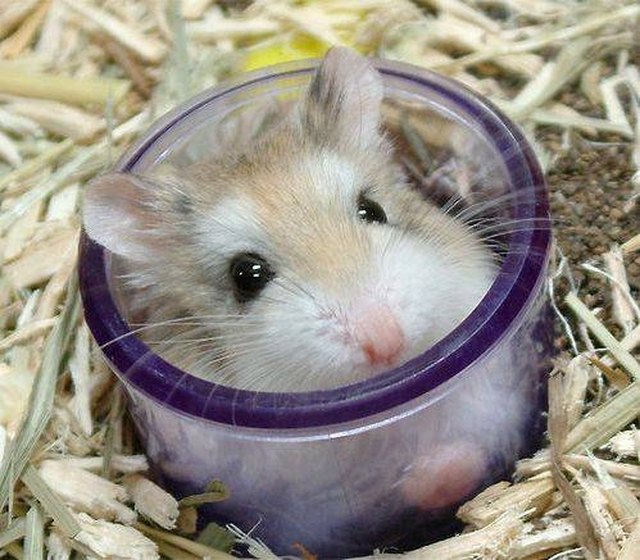 Give your hamster a nice home. When you get your new hamster,you'll need to provide it with a comfortable place to live. This means you need to set up a suitable cage for your hamster. You should put down some absorbent bedding to make your hamster feel comfortable. This also allows your hamster to go to the restroom in its cageBe sure to also put a water bottle for your hamster to drink out of in the cage.
Give your hamster a nice home. When you get your new hamster,you'll need to provide it with a comfortable place to live. This means you need to set up a suitable cage for your hamster. You should put down some absorbent bedding to make your hamster feel comfortable. This also allows your hamster to go to the restroom in its cageBe sure to also put a water bottle for your hamster to drink out of in the cage.
 Feed the hamster regularly. Hamsters are omnivores, which means they subsist on animal-based food as well as plant-based food. The most common thing to feed hamsters is dried hamster food pellets, but it is a good idea to supplement your hamster's diet with small pieces of raw fruits and vegetables as a treat a couple times per week.
Typically, hamsters should eat about 10 grams of dry hamster food twice each day.
For a treat, consider giving them small bits of broccoli, peaches, cauliflower, or bananas. Do not give your hamster anything citrus (like lemons or oranges) or acidic (like onions) because it could cause your hamster to get an upset stomach.
During the first few days after you get your hamster, be careful not to push yourself on it too quickly. This is especially important during feeding time. Just put the food in the cage and then leave the hamster alone to eat in peace. This will help your hamster feel safe around you.
Feed the hamster regularly. Hamsters are omnivores, which means they subsist on animal-based food as well as plant-based food. The most common thing to feed hamsters is dried hamster food pellets, but it is a good idea to supplement your hamster's diet with small pieces of raw fruits and vegetables as a treat a couple times per week.
Typically, hamsters should eat about 10 grams of dry hamster food twice each day.
For a treat, consider giving them small bits of broccoli, peaches, cauliflower, or bananas. Do not give your hamster anything citrus (like lemons or oranges) or acidic (like onions) because it could cause your hamster to get an upset stomach.
During the first few days after you get your hamster, be careful not to push yourself on it too quickly. This is especially important during feeding time. Just put the food in the cage and then leave the hamster alone to eat in peace. This will help your hamster feel safe around you.
 Wait a week before trying to touch it. You need to give your hamster some time to get used to you and to feel safe and settled in its new home. Don't try to force any contact with your hamster for the first week or so.
Sometimes this process can take a bit longer. It’s important for you to be patient in the beginning.
Wait a week before trying to touch it. You need to give your hamster some time to get used to you and to feel safe and settled in its new home. Don't try to force any contact with your hamster for the first week or so.
Wait a week before trying to touch it. You need to give your hamster some time to get used to you and to feel safe and settled in its new home. Don't try to force any contact with your hamster for the first week or so.
Sometimes this process can take a bit longer. It’s important for you to be patient in the beginning.
Wait a week before trying to touch it. You need to give your hamster some time to get used to you and to feel safe and settled in its new home. Don't try to force any contact with your hamster for the first week or so.
 Help your hamster recognize your voice. When you're in the same vicinity as your hamster's cage, try talking to your hamster in a soothing voice. You want your pet to begin to recognize your voice as this will help it learn to not fear you.
You may want to come near the cage and spend a few minutes at a time (several times each day) just speaking gently to your hamster.
You can even take the cage lid off after the first few days so that your hamster can hear you better. Just be careful to make sure it doesn't escape.
Sometimes this process can take a bit longer. t's important for you to be patient in the beginning.
Help your hamster recognize your voice. When you're in the same vicinity as your hamster's cage, try talking to your hamster in a soothing voice. You want your pet to begin to recognize your voice as this will help it learn to not fear you.
You may want to come near the cage and spend a few minutes at a time (several times each day) just speaking gently to your hamster.
You can even take the cage lid off after the first few days so that your hamster can hear you better. Just be careful to make sure it doesn't escape.
Sometimes this process can take a bit longer. t's important for you to be patient in the beginning.
 Give your hamster treats. Begin to feed your hamster with treats in between the cage bars or through an opening in the top of the cage, depending on what type of enclosure you have for your pet hamster. Associating you with treats will help your hamster get over being afraid of you.[5]
You can also rub the treat in your palm so the hamster can get to know your scent. Continue for a few days.
Give your hamster treats. Begin to feed your hamster with treats in between the cage bars or through an opening in the top of the cage, depending on what type of enclosure you have for your pet hamster. Associating you with treats will help your hamster get over being afraid of you.[5]
You can also rub the treat in your palm so the hamster can get to know your scent. Continue for a few days.
 Wash your hands. Before you try to pick up your hamster for the first time, you should wash your hands thoroughly. This will remove any scent of food that may be lingering on your hands. You don’t want your hamster to accidentally bite you.[6]
You can even wear gloves when picking up your hamster in the beginning if you are afraid of being bitten.
Wash your hands. Before you try to pick up your hamster for the first time, you should wash your hands thoroughly. This will remove any scent of food that may be lingering on your hands. You don’t want your hamster to accidentally bite you.[6]
You can even wear gloves when picking up your hamster in the beginning if you are afraid of being bitten.
 Start carefully inserting your hand into the cage. When your hamster is awake, slowly put your hand into the cage. Let your hamster sniff your hand. And don’t force it to do anything. If your hamster is acting scared and backing away from you, remove your hand and try again in another week or two.[7]
You can also include a couple of treats in your palm to help your hamster feel less afraid.
Don't pull away when your hamster makes sudden movements at you when you are going to pet or handle it. You are only going to scare it even if it scared you.
Start carefully inserting your hand into the cage. When your hamster is awake, slowly put your hand into the cage. Let your hamster sniff your hand. And don’t force it to do anything. If your hamster is acting scared and backing away from you, remove your hand and try again in another week or two.[7]
You can also include a couple of treats in your palm to help your hamster feel less afraid.
Don't pull away when your hamster makes sudden movements at you when you are going to pet or handle it. You are only going to scare it even if it scared you.
 Watch out for possible health problems. Since hamsters are such small creatures, you’ll need to monitor them closely for potentially dangerous health problems. While most hamsters are generally healthy, a problem can worsen quickly in a hamster’s tiny body.
The biggest health problem among hamsters is diarrhea. This condition needs quick vet attention since hamsters can perish from dehydration. The telltale sign that your hamster has diarrhea is when your hamster’s rear end looks wet and brownish in color.
Another common medical complication for hamsters is protrusion of the eyeball from the socket. This is usually caused by an eye infection or by some other kind of physical trauma. If your hamster’s eyes look like they are bulging, take it to the vet immediately.
Watch out for possible health problems. Since hamsters are such small creatures, you’ll need to monitor them closely for potentially dangerous health problems. While most hamsters are generally healthy, a problem can worsen quickly in a hamster’s tiny body.
The biggest health problem among hamsters is diarrhea. This condition needs quick vet attention since hamsters can perish from dehydration. The telltale sign that your hamster has diarrhea is when your hamster’s rear end looks wet and brownish in color.
Another common medical complication for hamsters is protrusion of the eyeball from the socket. This is usually caused by an eye infection or by some other kind of physical trauma. If your hamster’s eyes look like they are bulging, take it to the vet immediately.
 Deal with problems among pets. Hamsters can be territorial creatures, which means that they may not like to share their cage with other animals, including other hamsters. If your hamsters are fighting among themselves, you may need to separate them permanently into different cages.
At the very least, make sure there are no closed off portions of the habitat where one hamster can corner another. And try to make sure there is two of everything so they don’t fight over food and water.
If you need mor help press the link! HAMSTER HELP :)
ILY's Website!
Deal with problems among pets. Hamsters can be territorial creatures, which means that they may not like to share their cage with other animals, including other hamsters. If your hamsters are fighting among themselves, you may need to separate them permanently into different cages.
At the very least, make sure there are no closed off portions of the habitat where one hamster can corner another. And try to make sure there is two of everything so they don’t fight over food and water.
If you need mor help press the link! HAMSTER HELP :)
ILY's Website!

